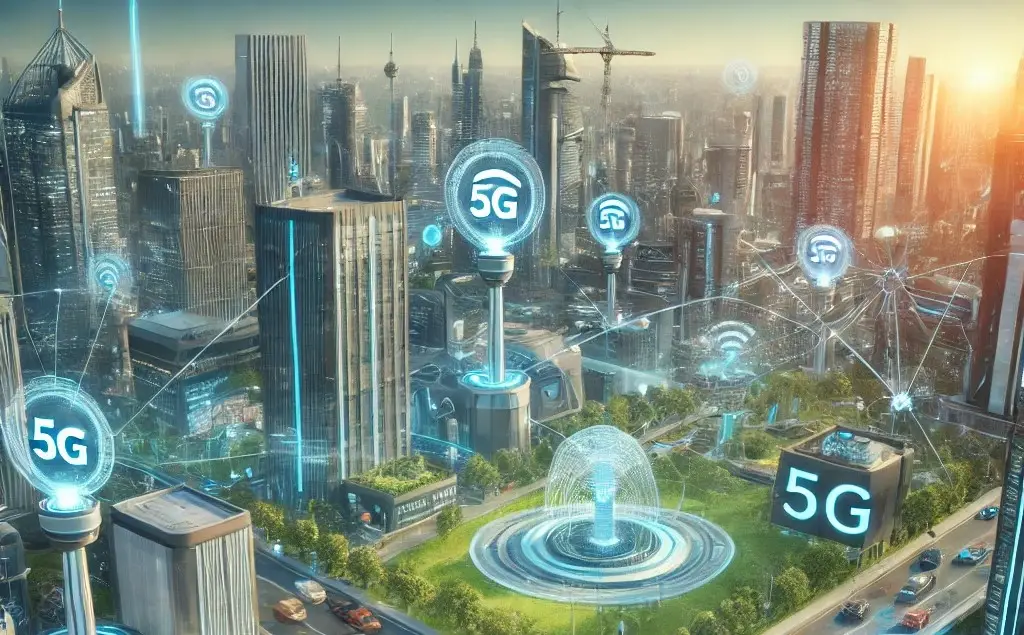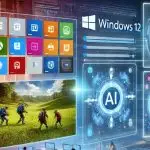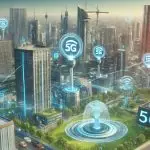The evolution of mobile networks has been a remarkable journey. From the early days of 1G, where voice calls were a novelty, to 4G LTE, which revolutionized mobile data and the internet, each generation of mobile technology has dramatically transformed how we communicate, work, and entertain ourselves. Now, as we approach 2025, the world is set for the next phase of this transformation: 5G.
5G promises to be a game-changer, offering faster speeds, lower latency, and the ability to connect billions of devices in real-time. While 5G technology has already begun to roll out, its full potential will become more apparent in 2025, as networks mature and new applications emerge. In this article, we will explore what we can expect from the evolution of 5G in 2025 and how it will impact various industries, consumers, and society as a whole.
1. Enhanced Speed and Connectivity: A New Era of Mobile Communication
One of the most exciting aspects of 5G is its potential to deliver speeds that are up to 100 times faster than current 4G LTE networks. This enhanced speed will make everything from downloading movies to playing high-definition games on mobile devices a seamless experience. In 2025, 5G speeds are expected to reach up to 20 Gbps in ideal conditions, allowing users to download entire movies in seconds and enjoy ultra-high-definition (UHD) streaming with little to no buffering.
Impact on Consumers
For the average consumer, this means faster, more reliable mobile experiences. The days of waiting for videos to buffer or downloading apps that take forever will be a thing of the past. 5G will also enable more advanced applications, such as augmented reality (AR) and virtual reality (VR), to be used on mobile devices without lag. With ultra-fast internet speeds, consumers will be able to stream 8K video content with ease, access cloud gaming services, and use real-time video communication without delay.
Impact on Businesses
For businesses, faster speeds will allow for better collaboration, especially in fields like video conferencing, data sharing, and cloud computing. Large teams working remotely will benefit from uninterrupted, high-quality video calls, and businesses can rely on faster data transfer for activities like cloud-based work or data backups. 5G will also enable the use of data-heavy applications such as real-time data analytics and artificial intelligence (AI) models that require quick data input and processing.
2. The Rise of 5G-Enabled Devices: The Hardware Revolution
By 2025, the number of 5G-enabled devices will skyrocket. Currently, 5G-compatible smartphones and tablets are available, but as 2025 approaches, we will see a wide range of other devices supporting 5G technology. From laptops to wearables, IoT (Internet of Things) devices, and even connected cars, 5G will be the driving force behind the next generation of connected hardware.
Mobile Phones and Tablets
The most obvious and widespread devices that will benefit from 5G will be smartphones and tablets. In 2025, most new models of mobile phones will come with 5G connectivity as a standard feature. Major brands like Apple, Samsung, and Google will continue to improve their devices, integrating more powerful processors and advanced 5G technology that takes full advantage of the network’s capabilities.
With better speeds, consumers will be able to enjoy seamless experiences, whether they are browsing the web, streaming content, or playing mobile games. The integration of 5G with AI will also allow devices to process information much faster, delivering smarter, more responsive interfaces.
Wearables and IoT Devices
Wearables such as smartwatches, health trackers, and fitness devices are increasingly being equipped with 5G capabilities. These devices will be able to transmit health data in real-time to healthcare professionals, allowing for better patient monitoring and care. In the consumer sector, wearables will become more integrated into our daily lives, offering personalized recommendations and alerts, while in the industrial sector, connected IoT devices will communicate with each other faster and more efficiently.
Autonomous Vehicles
In 2025, autonomous vehicles will rely heavily on 5G networks to enable real-time communication between the car, the surrounding infrastructure, and other vehicles. This will allow for safer and more efficient self-driving cars, reducing the chances of accidents and improving traffic flow. 5G’s ultra-low latency ensures that information can be exchanged between vehicles and traffic lights within milliseconds, enabling cars to react to road conditions or potential hazards faster than ever before.
3. Expansion of Smart Cities: Building the Future with 5G
The concept of smart cities has been around for several years, but with the deployment of 5G, we will see real progress in making these futuristic urban spaces a reality by 2025. 5G will enable real-time communication between city infrastructure, sensors, and people, allowing cities to become more efficient, sustainable, and safer.
Smart Traffic and Transportation Systems
Traffic management is one of the biggest challenges facing modern cities, but 5G will help optimize traffic flow by enabling smart traffic signals and real-time traffic updates. Vehicles will be able to communicate with traffic lights, road signs, and even each other, ensuring that traffic moves efficiently and reducing congestion.
In addition to reducing traffic jams, 5G will allow for better public transportation systems. For example, buses and trains will be able to adjust routes and schedules based on real-time data, ensuring that public transport is always on time and meeting the needs of passengers.
Public Safety and Emergency Response
Public safety will also benefit greatly from 5G. With better connectivity, emergency services will be able to communicate in real-time and respond more quickly to incidents. 5G will also enable the widespread use of drones for surveillance, traffic monitoring, and even search-and-rescue operations. Smart surveillance systems will use AI to detect incidents and immediately notify authorities.
4. The Growth of Autonomous Vehicles: A 5G-Driven Revolution
Autonomous vehicles (AVs) are expected to play a major role in transforming transportation by 2025, and 5G will be a key enabler of this revolution. Self-driving cars rely on vast amounts of data to navigate and make real-time decisions. With 5G’s ultra-low latency and high-speed capabilities, AVs will be able to communicate instantly with other vehicles, infrastructure, and the cloud, enabling safer and more efficient travel.
Vehicle-to-Everything (V2X) Communication
In 2025, Vehicle-to-Everything (V2X) communication will be a standard feature in most autonomous vehicles. V2X enables cars to communicate with each other (Vehicle-to-Vehicle or V2V), with traffic infrastructure (Vehicle-to-Infrastructure or V2I), and with pedestrians or cyclists (Vehicle-to-Pedestrian or V2P). This system will reduce accidents, optimize traffic flow, and allow autonomous vehicles to operate more safely and efficiently.
5. Transforming Entertainment and Media: A New Era of Content Delivery
The entertainment industry is set to be transformed by 5G in the coming years. With faster speeds, lower latency, and the ability to handle large amounts of data, 5G will unlock a whole new level of entertainment experiences for consumers.
Ultra-High-Definition Streaming
5G will enable ultra-high-definition (UHD) and 8K video streaming with virtually no buffering. This means that content providers like Netflix, YouTube, and Amazon Prime will be able to deliver crystal-clear video content directly to your device, regardless of where you are. Sports fans will be able to watch live events in stunning detail, and VR and AR applications will become more realistic and immersive than ever before.
Cloud Gaming
5G will revolutionize gaming by enabling cloud gaming services to function without the need for expensive gaming consoles. Services like Google Stadia, Microsoft’s Project xCloud, and NVIDIA GeForce Now will benefit from 5G’s low latency, providing gamers with a lag-free experience. This will make high-quality gaming accessible to more people, regardless of their hardware.
6. The Impact on Remote Work and Education: Enhancing Productivity
With the global shift toward remote work and online learning, 5G will play a crucial role in improving productivity and collaboration. In 2025, we will see the full impact of 5G on both remote work and education.
Remote Work
Remote workers will benefit from faster and more reliable internet connections, making virtual meetings, file sharing, and cloud computing more seamless. High-quality video conferencing will become the norm, with no lag or interruptions. Real-time collaboration on projects will be easier, allowing teams to work together as if they were in the same room.
Remote Learning
In education, 5G will enable high-quality online courses, live-streamed lectures, and interactive learning experiences. Students will have access to high-definition video lessons, real-time quizzes, and immersive AR/VR experiences that make learning more engaging and interactive.
7. Health Tech Revolution: The Future of Medicine
5G will also revolutionize healthcare, allowing for better monitoring, diagnosis, and treatment. In 2025, we will see the full potential of 5G in healthcare.
Telemedicine and Remote Surgery
Telemedicine, or virtual doctor visits, will become more common, as 5G enables high-definition video consultations with healthcare professionals. Surgeons will be able to perform remote surgeries using robotic systems controlled via 5G networks, ensuring minimal latency and maximum precision.
Wearable Health Devices
Wearable health devices, such as smartwatches and fitness trackers, will become even more sophisticated, transmitting real-time health data to doctors and hospitals. This will allow for more personalized and proactive healthcare, as doctors will have access to continuous health data, enabling earlier diagnosis and treatment.
The Future of 5G in 2025
As we move closer to 2025, 5G will become a central part of the technological landscape. From enhancing speed and connectivity to enabling the development of smart cities, autonomous vehicles, and health tech innovations, 5G will have a profound impact on nearly every aspect of our lives. The true potential of 5G will only be realized as its infrastructure expands, devices become more widely available, and industries learn to leverage its capabilities. The evolution of 5G will shape the future of communication, transportation, healthcare, and entertainment, making 2025 an exciting year for tech enthusiasts and consumers alike.










